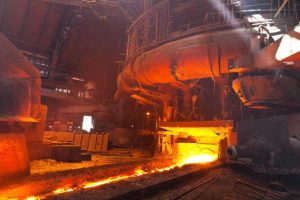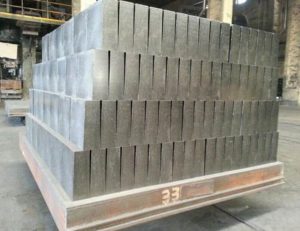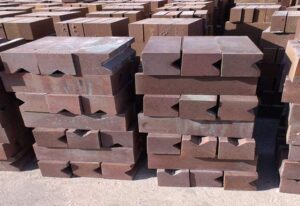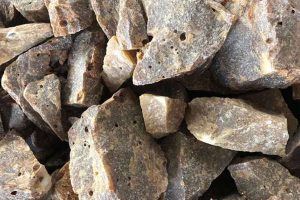Verfeinerungsköpfe Schlackelinien -Teile mit direkter Bindung, Wiederherstellung (Halbre-Bonding) Magnesium-Chrom-Ziegel-Substitute, Inländische und fremde Auswahl der ultrahoch-hohen Temperaturfeuerung von Hochpility-Magnesia-Dolomitziegel, Die Merkmale des Ziegelprozesses sind hauptsächlich: synthetische Magnesie Dolomitsand und hohe Püre-Magnesia-Sand als Rohstoffe, wasserfreies Bindungsmittel, Hochdruckformen, Ultrahohe Temperatur (1700 ℃ oder höher) Brennen und Produkte zur Erfassung von Wasserdichtungsmaßnahmen.
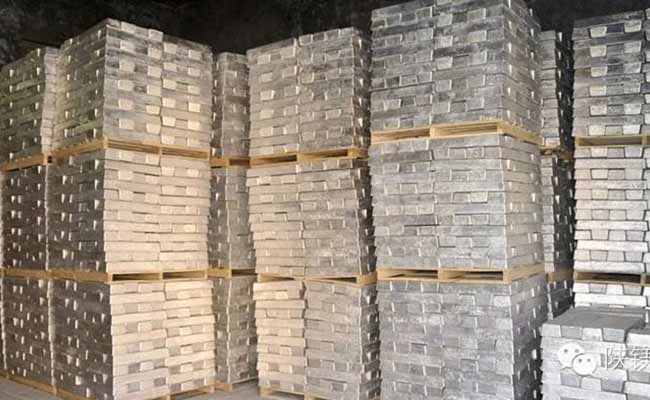
Magnesia Dolomit Ziegelleistung Eigenschaften
01. Guter Hochtemperaturwiderstand
Der Schmelzpunkt der Hauptkomponenten MGO und CAO sind bis zu 2800 ℃ bzw. 2600 ℃, und die eutektische Temperatur von beiden beträgt auch 2370 ℃. Die Mikrostruktur wird durch MGO/CAO bestimmt, Die direkte Kombination der beiden ist jedoch das Hauptmerkmal der Mikrostruktur. Als Gesamtmenge an Verunreinigungen (SiO2, Fe2O3, und Al2O3) im Allgemeinen nicht überschreitet 3%, Manchmal nicht mehr als 2.5%, Die Lastweichung beginnt bei einer Temperatur von mehr als 1700 ℃.
02. Hohe thermodynamische Stabilität
Aufgrund der negativsten freien Energie von CAO (am stabilsten), unter Vakuummagnasia Dolomitziegel als Magnesium-Chrom-Ziegelstabilität, Die Möglichkeit der Wiederherstellung des Stahls ist minimal. Solange der Feuerstein ~ hat 20% Cao, Es wird die relative Verflüchtigung von MGO erheblich niedriger machen (Aufgrund der geringen Menge an fester Fusion von CAO in MGO und MGO bevorzugt die Verflüchtigung, im MGO-CAO-Material zur Bildung einer CAO-reichen Schicht). Diese thermodynamische Stabilität von Brandmagnesia-Dolomitziegel bestimmt ihre Anwendbarkeit bei der Verwendung von Stahltanks für außerhalb des Furnastes, die unter Hochtemperatur-Vakuum arbeiten.
03. Stahlkapazität reinigen
Sauberstahl benötigt Stahltankauskleidung, die den Stahl nicht kontaminiert und vorzugsweise den Stahl reinigen kann. Abgefeuerte Magnesia -Dolomitziegel enthält 20% Free CAO hat einen offensichtlichen Entschwefelungseffekt, Es kann als Auskleidung eines Desulfurisationsstahltanks verwendet werden.
04. Ausgezeichneter Schlackenwiderstand
Magnesia -Dolomitziegel mit freiem CAO ist anpassungsfähiger an die Schlacke: Es hat eine starke Erosionsbeständigkeit gegen hohe Alkalinität (High CAO/SiO2 &) Schlacke. Niedrige Alkalinitätsschlacke, Aufgrund der hohen Aktivität von freiem CAO im Ziegel reagiert es bevorzu, die an der Arbeitsfläche des Ziegels haftet, Blockieren der Poren und Verhinderung einer weiteren Erosion der Schlacke am Futterstein. Jedoch, Der Verlust von MGO-CAO-feuerfest in CaO-AL2O3-Schlacke ist ziemlich schwerwiegend und nimmt mit zunehmender CaO/MGO-Verhältnis im Ziegel zu., Weil der freie CAO im Ziegel in CaO-AL2O3-Schlacke sofort schmilzt und niedrige Schmelzpunktsubstanzen wie 12CAO-7Al2O3 erzeugt, die in einem geschmolzenen Zustand von der Ziegeloberfläche entlassen wird, und die Ziegeloberfläche kann keine Schutzschicht bilden und die Zerstörung beschleunigen. Obwohl MGO-CAO-Refraktionen durch hohe CaO/SiO2, Sie sind leicht zu erodieren, wenn sie auch Fe2O3 und AL2O3 enthalten, und die Resistenz von MGO-CAO-Refraktionen gegen CaO-AL2O3-Schlacke-Erosion steigt mit zunehmender MGO/CAO-Verhältnis. Es kann geschlossen werden, dass der abgefeuerte Magnesia -Dolomitziegel ungefähr ungefähr 80% MGO hat eine höhere Erosionsresistenz gegen diese Schlacke.
Wenn die Gesamtmenge an Rohmaterialverunreinigungen (SiO2 + Al2O3 + Fe2O3) ist weniger als 2%, Die Schüttdichte des synthetischen Magnesia -Dolomitsands ist größer als 3.2 # CM3 und Ziegelbrandtemperatur als Magnesia -Dolomitziegel, dieser Ziegelstein (Einige Menschen nannten die direkte Bindung Magnesia Dolomitziegel) In der Raffinerie -Tankschlackelin.
Berücksichtigung des Hochtemperatur-Brandprozesskomplexes, hohe Investition, und hoher Energieverbrauch, Anstatt die Umgebung zu verschmutzen, um wasserfreies phenolisches Harz in Kombination mit der Maschine, die nicht verbrannt wird, Magnesia -Dolomitziegel verbrannt, In den Stahltankschlackleitungsteilen, die auch mit Brandmagnesia -Dolomitziegel erreicht werden, ähnlich der Verwendung des Effekts.
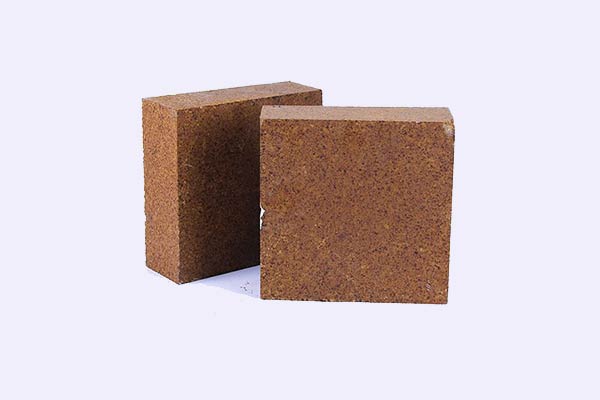
Zwei Nachteile von Magnesia -Dolomitziegel
01. Die Expansionsrate der Brandlinie ist groß (1600 ℃ bis 1.8% ~ 2.0%) zur gleichen Zeit neu abgestimmte Schrumpfungsrate von 0.35% ~ 0.61%. Harz gebundenes nicht fester Magnesia-Dolomitziegel hat auch eine hohe thermische Expansion, und Schrumpfung beim Abkühlen nach dem Gebrauch von Hochtemperaturen. In diesem Fall, Die Ziegelfutterfugen rissen, Manchmal konzentrierten sich große Risse. Wenn diese Art von Stahltank weiter verwendet wird, Hochtemperaturstahl und Schlacke werden durch die großen Risse auslaufen, die Stahlleckunfälle verursachen.
02. MGO-CAO-Systemfeuerfeuer sind leicht hydratisiert. Zusätzlich zur Einnahme von Wasserdichtheitsmaßnahmen im Ziegelbetragungsprozess, Es sollten Maßnahmen ergriffen werden, um den Kontakt mit Wasser zu vermeiden, Wasserdampf, und sogar Luft im Transport, Lagerung, Mauerwerk, und Verwendung der Produkte. Zum Beispiel, Die Oberfläche der Produktthermoplastik oder Produkte in versiegelten Behältern (Vakuum) im Lager. Der versiegelte Behälter von Calcium -Magnesiumprodukten muss sofort für Mauerwerk und andere Bauprozesse verwendet werden, und so schnell wie möglich zu backen und in Gebrauch zu nehmen, Bei der Verwendung des Prozesses, um die Temperatur des Produkts zu vermeiden, fällt unten ab 600 ℃.

